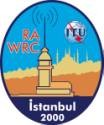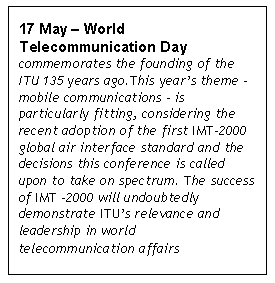World Radiocommunication Conference

| WRC2000 World Radiocommunication Conference |
Highlights |  |
| 8 May-2June | ||
|
|
||
| Istanbul, 15 May 2000 | N� 6 | |
| 12 May issue | ||
The non-GSO/GSO case
The sharing conditions
in the band 10-18 GHz between the non-geostationary satellites (non-GSO FSS) and
existing or planned geostationary satellites of the fixed and
broadcasting-satellite services (GSO FSS and GSO BSS) led to the adoption of
provisional power limits in 1997 to allow for studies to be undertaken. Despite smooth-sailing
discussions in the CPM, the debate was re-opened where some delegations
considered that more balanced sharing arrangements between the GSO and non-GSO
systems were needed. A small drafting group was therefore set up (C5D3) to look
at the various proposals. In considering the use of the band by non-GSO FSS, for
which filing has been made prior to 22 November 1997 (Footnote S5.516), the
drafting group was requested, as a working assumption, to deal with the global
proposals from the specific proposals of countries of the Americas (Region 2)
separately and prepare two texts. Working Group 5D, in considering the proposed
texts, will consider whether or not to combine them into a single footnote. The
other text to be prepared concerns the current restriction imposed to the FSS
uplink which limits the use of the band to feeder links for the
broadcasting-satellite service. The drafting group was asked to meet on 16 May and the
proponents were requested to make use of the time to meet informally and resolve
their differences before the meeting of the drafting group. The other point of discussion addressed the problem of
sharing between space and terrestrial services in the band 11.7-12.2 GHz in the
Americas region (Region 2). Before WRC-97, sharing was made possible by the
application of a provision of the Radio Regulations (Article 14, now S9.21). At
WRC-97, reference to this provision for sharing in this band disappeared,
leaving no defined criteria upon which to base the protection of terrestrial
services from the satellite services � except for the general principles found
in a footnote in the Table of Allocations (S5.488). These principles subject the
use of the band by the fixed-satellite service to prior agreement between the
administrations and those operating services. The Conference Preparatory Meeting
proposed three options: the status quo ante, the establishment of pfd limits or
coordination thresholds. Two trends emerged from the discussions: those preferring
the pfd limits and those (most countries of Region 2) favouring coordination
thresholds. It was argued that coordination offers better opportunities for
certain applications such as direct-to-home television using small antennas like
VSAT. At the same time, such limits could affect existing or already planned
networks. If no limits are applicable, satellite operators can decide on the
strength of the signals and, in so doing, have a more appealing business
offering for customers who could use smaller, and therefore cheaper, receiving
antennas. On the other hand, some concerns have been expressed concerning the
protection of the terrestrial services under this approach. In light of divided
views on the matter, it was concluded that a package would have to be worked out
by delegations to arrive at a workable solution. IMT-2000 satellite component The meeting considered the detailed proposals from which
two main trends emerged: those who did not consider it necessary to identify, at
this conference, any new band for the satellite component of IMT-2000 and those
who did. In the second group, most proposals had sufficient commonality to find
a consensus. In order to move forward, a drafting group was set up to consider
ways to harmonize the proposals that had identified possible bands and hence
facilitate the discussions by sub-working group 5A-1. These
conditions were particularly important for �broadband� global satellite
systems which have the potential to deliver Internet and multimedia applications
to homes and businesses anywhere in the world. This was one of the most
controversial issues of the 1997 conference. While the Conference Preparatory
Meeting (CPM) brought parties close together on those limits, it is up to
WRC-2000 to review them on the basis of the studies carried out since 1997.
These
conditions were particularly important for �broadband� global satellite
systems which have the potential to deliver Internet and multimedia applications
to homes and businesses anywhere in the world. This was one of the most
controversial issues of the 1997 conference. While the Conference Preparatory
Meeting (CPM) brought parties close together on those limits, it is up to
WRC-2000 to review them on the basis of the studies carried out since 1997.
Drafting group 5B-2 completed its work on the status of allocations other than RNSS in 1559-1610 MHz band (agenda 1.15.3). It essentially agreed that, while taking all practicable measures to protect the radionavigation-satellite service and not authorize new assignments to fixed service systems in this band,
High-Density Fixed Systems
A small ad hoc group was set up to consider all allocation issues in the 37.0-43.5 GHz range including a split of sub-bands between the high-density fixed service and the high-density fixed satellite service because of their incompatibility to share the same band.
A Resolution was also agreed and forwarded to GT PLEN/2, adding one more item to the already impressive list of 85 items for WRC-03! The Resolution requests the ITU to conduct sharing studies between spaceborne precipitation radar and other services in band 35.5-35.6 GHz for the possible exclusion, by WRC-03 of the current constraints imposed on this type of radar operating in this particular band. The constraints require that radars cause no harmful interference to, nor claim protection from, or otherwise impose any constraints in, the operation and development of the radiolocation, earth-exploration satellite (active), meteorological aids and space research (active) services.
Informal discussions
There was no headway on the issue of whether this Conference is mandated to consider alternative bands for a possible allocation to the mobile-satellite service (see WRC2000 Highlights of 11 May under The quest for spectrum by the mobile-satellite service). It was therefore decided to refer the matter to Committee 5.
The question of spurious emissions resolved
Working Group 4B
Today, Working Group 4B successfully completed its mandate on the question of spurious emissions for all transmitters in all frequency bands. The differences which had emerged at the group�s first meeting (see WRC2000 Highlights of 9 May, Review of Appendix S3 to the Radio Regulations) were smoothly ironed out, thanks to the negotiations carried out in Sub-Working group 4B1. It was agreed not to split into categories the limits of the spurious emissions concerning space and earth stations.
Of significant importance was the agreement reached today to revise the maximum permitted spurious emission power levels for transmitters to be installed on, before, or after 1 January 2003. These new values will be valid until January 2012.
The Working Group further concluded that issues related to unwanted emissions should be forwarded to GT PLEN 2 for inclusion in the agenda of the next WRC and has sent a report to Committee 4 with that advice. It also concluded that the general out-of-band emission limits should not be considered for inclusion in the agenda of the next conference.
Furthermore, the Working Group agreed on the suppression of Recommendation 507, which relates to spurious emissions in the broadcasting-satellite service.
Negotiations continue on earth stations on board vessels
According to a report presented this morning by Sub-Working Group 4B2, the two divergent positions that emerged when discussion on this issue began on 9 May 2000 remain, for the most part, unchanged on the regulatory and technical provisions to enable earth stations located on board vessels to operate in the fixed-satellite service networks in the bands 3700�4200 MHz and 5925�6425 MHz.
The Inter-American-American Telecommunications Commission (CITEL) and the Asia-Pacific Telecommunity (APT) continued to advocate the use of frequency bands by earth stations on board vessels, subject to complying with requirements regarding the protection of terrestrial services (for example, coordination when approaching a coastal area or port).
Europe, Africa, and the Arab Group, continued to oppose the provisional use of these bands by earth stations on board vessels because studies on compatibility and interference with terrestrial services are yet to be completed.
What is a footnote? Footnotes are an integral part of the Table of Frequency Allocations in the Radio Regulations which provide flexibility in the use of allocations by different countries. They are, in effect, exceptions to the agreed allocation. Footnotes are included only when the exception has international implications for the use of the radio-frequency spectrum. Agenda item 1.1, dealing with footnotes permits requests from administrations to delete their country footnotes or to have their country�s name deleted from footnotes, if no longer required.
However, Working Group 4B noted that many of the proposals submitted included the addition of country names to existing footnotes. In several cases, these proposed additions were received by the ITU following the 8 January 2000 deadline.
Meanwhile, the Working Group has concluded that the issue of adding country names to footnotes is a matter for the Plenary of the Conference to decide and has put this issue in abeyance, pending new directions when the next Plenary meets.
Review of Recommendations and Resolutions
A number of the procedures contained in the Radio Regulations including their associated Resolutions and Recommendations, have served their time and need to be deleted or updated. An example is Recommendation 402. First adopted by the World Administrative Radio Conference on the aeronautical mobile (R) service in 1978, as an initial tool for the coordination of requirements for worldwide frequencies in the allotments prescribed in the Radio Regulations (Appendix S27), this Recommendation has undergone many revisions.
At this Conference, delegations were being asked to consider whether Recommendation 402 should be suppressed considering the ever-increasing non-observance of the related procedures which are strictly voluntary or whether an alternative mandatory procedure should be adopted so as to preserve the integrity of the worldwide system for long-distance aeronautical operational control communications (AOCC).
What should be remembered here is that when revised by WARC 79, Recommendation 402 established a mechanism for a voluntary coordination between administrations, through both ITU and the International Civil Aviation Organization (ICAO), intended to ensure an efficient use of worldwide frequencies, while preserving the rights of administrations to use any frequency assignment in conformity with the relevant procedures of the Radio Regulations.
Countries have long cooperated in following the joint ITU/ICAO procedure for the choice of frequencies for long-distance AOCC. However, in some cases countries also preferred to exercise their rights in putting into operation frequency assignments, on the worldwide frequencies, which were not in accordance with the List of coordinated frequencies.
Despite the concerns expressed by ITU and ICAO, notification of assignments of the worldwide frequencies for long-distance AOCC that were not in accordance with the ITU/ICAO List of coordinated frequencies continued and the provisions of Recommendation 402 ignored, for the most part. As the procedure of this Recommendation is not mandatory, the ITU was obliged to accept such notifications.
Statistical data clearly points to the current irrelevance of the procedures of Recommendation 402.
As ICAO was not in the room to comment, the matter was put in abeyance pending comments from that organization.
A number of Resolutions and Recommendations have already been submitted to Sub-Working Group 4B4 for review.
Satellite Coordination procedures
Working Group 4A
Working Group 4A completed the introduction of proposals on the simplification of coordination procedures and set up four more Sub-Working Groups (SWG 4A-5, SWG 4A-6, SWG 4A-7 and SWG 4A-8). In essence, these groups will prepare and propose modifications to the Radio Regulations concerning the simplification and refinement of satellite coordination procedures and processing as well as processing charges for satellite network filings.
| Not an official document - For information only | |
| 12 May issue | 16 May issue |